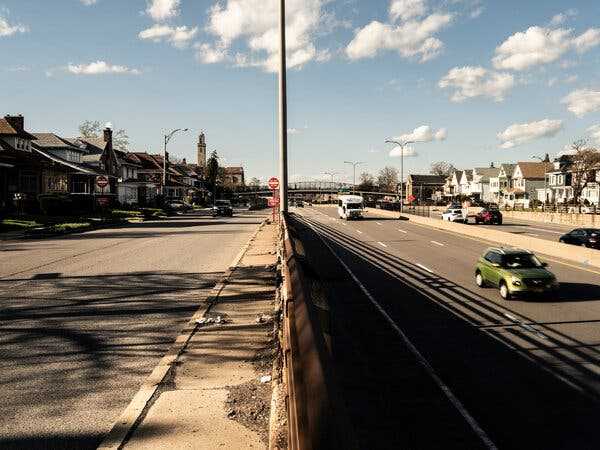The Biden administration is spending billions to reconnect communities of color that have been fragmented by highways. Some projects have stirred debates over how to mend longstanding harms.
- Share full article

The six-lane Kensington Expressway, built in the 1950s and ’60s, has long depressed property values and stifled economic development on Buffalo’s East Side.
Around 6:30 every morning, David Richardson is usually awakened by the swelling sound of traffic. Steps from his front yard, thousands of cars rumble past each day as they travel along the Kensington Expressway, an expansive six-lane highway that slices through his neighborhood on Buffalo’s East Side.
The expressway, built in the 1950s and ’60s to move cars faster between downtown Buffalo and its suburbs, has long depressed property values and stifled economic development in this low-income and predominantly Black community. It has also posed a physical barrier, making it harder for residents to reach grocery stores and parks.
New York State is now trying to revitalize the neighborhood with support from a new Biden administration program meant to stitch together primarily disadvantaged communities that have long been splintered by transportation projects. The state plans to reconnect the neighborhood by essentially converting a portion of the highway into a tunnel with green space on top that would link both sides. State officials say the $1 billion project, backed by a $55.6 million federal grant, will enhance pedestrian access and stimulate economic growth.
The effort has spurred intense backlash among some residents, who believe it will do little to address air pollution or increase access to economic opportunities. They include Mr. Richardson, 69, a retired electrician who moved to the neighborhood nearly a decade ago. He said that he did not think covering a section of the highway would do much to improve the area’s air quality and that he would rather see the highway completely torn out.
“If they’re going to restore the community, they should do it right,” Mr. Richardson said.
In the 1950s and ’60s, highways often rammed through Black neighborhoods, destroying cultural and economic centers and bringing decades of environmental harm. Research has found that people living near major roads and highways are exposed to higher levels of traffic-related air pollution, which has been associated with lung and heart problems, low birth weight and premature death.
Image“If they’re going to restore the community, they should do it right,” said David Richardson, who has lived in the neighborhood nearly a decade.Credit…Joshua Rashaad McFadden for The New York Times
We are having trouble retrieving the article content.
Please enable JavaScript in your browser settings.
Thank you for your patience while we verify access. If you are in Reader mode please exit and log into your Times account, or subscribe for all of The Times.
Thank you for your patience while we verify access.
Already a subscriber? Log in.
Want all of The Times? Subscribe.
SKIP ADVERTISEMENT
Source: nytimes.com



